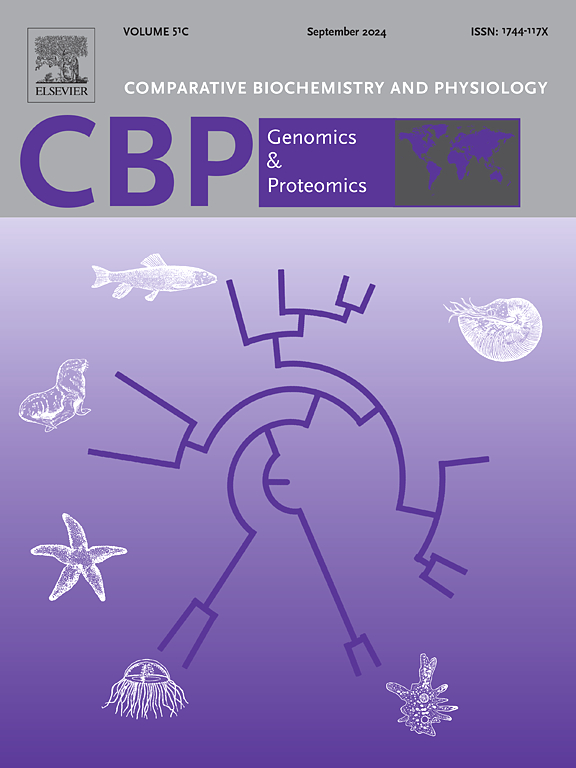生物化学和代谢组学揭示了盐胁迫下缢蛏体内渗透压的调节机制
IF 2.2
2区 生物学
Q4 BIOCHEMISTRY & MOLECULAR BIOLOGY
Comparative Biochemistry and Physiology D-Genomics & Proteomics
Pub Date : 2025-07-10
DOI:10.1016/j.cbd.2025.101578
引用次数: 0
摘要
盐度是影响海洋生物生长、发育、生存和繁殖的重要环境因素。缢蛏(Sinonovacula constricta)是滩地和池塘养殖中具有重要经济价值的双壳类动物,由于河流径流和降水等因素,其盐度经常出现剧烈波动。这些盐度的突然变化会对其产量产生不利影响。然而,急性盐度胁迫对缢蛏渗透压和代谢过程的影响尚不清楚。因此,本研究研究了急性盐胁迫对维持在18 ~ 22盐胁迫下的缢蛏血淋巴渗透压、血清离子浓度和血清代谢物的影响。血清渗透压有显著变化(P <;0.05),与海水渗透压非常相似。血清中Na+、K+和Cl−的浓度也发生了显著变化(P <;0.05), 12 h后趋于稳定,这与渗透压变化趋势一致。代谢组学分析发现差异代谢物主要参与磷脂代谢、羧酸代谢和氨基酸代谢,表明离子通道和能量代谢途径的激活。缢蛏通过协调离子通道调节、神经相关代谢物和氨基酸分解代谢来对抗渗透应激,通过代谢重编程维持能量稳态。具体来说,蟒蛇通过离子(Na+, K+, Cl−)和关键代谢物(如甘油磷酸盐,牛磺酸,脯氨酸,花生四烯酸)克服渗透胁迫,揭示了新的信号代谢物,突出了生物大分子和代谢物在水产养殖双壳类动物健康评估中的重要作用。本文章由计算机程序翻译,如有差异,请以英文原文为准。

Biochemistry and metabolomics revealed the regulation mechanism of osmolality in Sinonovacula constricta under salinity stress
Salinity is a critical environmental factor that significantly influences the growth, development, survival, and reproduction of marine organisms. Sinonovacula constricta, an economically important bivalve in tidal flat and pond aquaculture, frequently encounters acute salinity fluctuations due to factors such as river runoff and precipitation. These abrupt changes in salinity can adversely affect its yield. However, the impacts of acute salinity stress on the osmolality and metabolic processes of S. constricta remain poorly understood. Therefore, this study investigates the impacts of acute salinity stress on hemolymph osmotic pressure, serum ion concentrations, and serum metabolites of S. constricta maintained at a salinity of 18 ppt to 22 ppt. Significant alterations in serum osmolality were observed (P < 0.05), closely resembling seawater osmolality. The concentrations of Na+, K+, and Cl− in serum also exhibited significant changes (P < 0.05), stabilizing after 12 h, which is consistent with the trends in osmotic pressure. Metabolomics analysis identified differential metabolites primarily involved in phospholipid metabolism, carboxylic acid metabolism, and amino acid metabolism, indicating the activation of ion channels and energy metabolism pathways. S. constricta combats osmotic stress via coordinated ion channel regulation, neural-related metabolites,and amino acid catabolism, maintaining energy homeostasis through metabolic reprogramming. Specifically, S. constricta overcomes osmotic stress through ions (Na+, K+, Cl−) and key metabolites (e.g., glycerophosphate, taurine, proline, arachidonic acid), reveals novel signaling metabolites, highlighting the significant role of biomacromolecules and metabolites in assessing the health of bivalves in aquaculture.
求助全文
通过发布文献求助,成功后即可免费获取论文全文。
去求助
来源期刊
CiteScore
5.10
自引率
3.30%
发文量
69
审稿时长
33 days
期刊介绍:
Comparative Biochemistry & Physiology (CBP) publishes papers in comparative, environmental and evolutionary physiology.
Part D: Genomics and Proteomics (CBPD), focuses on “omics” approaches to physiology, including comparative and functional genomics, metagenomics, transcriptomics, proteomics, metabolomics, and lipidomics. Most studies employ “omics” and/or system biology to test specific hypotheses about molecular and biochemical mechanisms underlying physiological responses to the environment. We encourage papers that address fundamental questions in comparative physiology and biochemistry rather than studies with a focus that is purely technical, methodological or descriptive in nature.

 求助内容:
求助内容: 应助结果提醒方式:
应助结果提醒方式:


